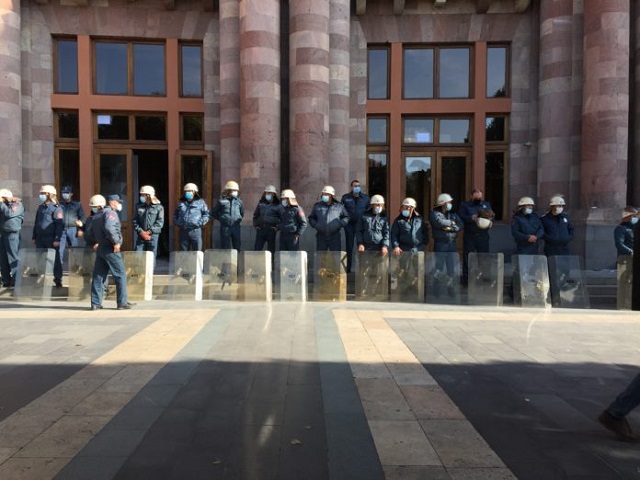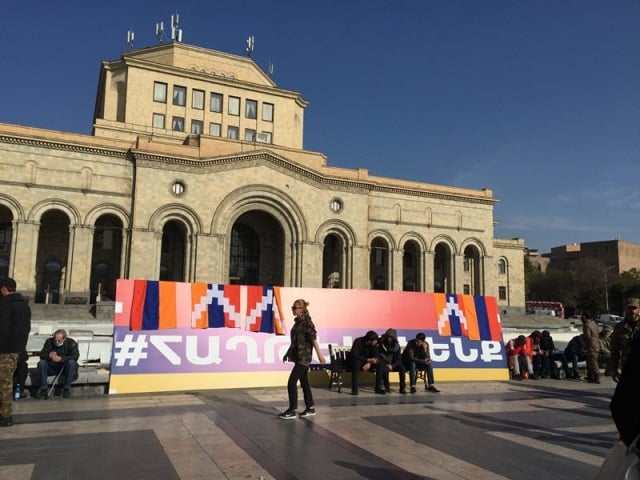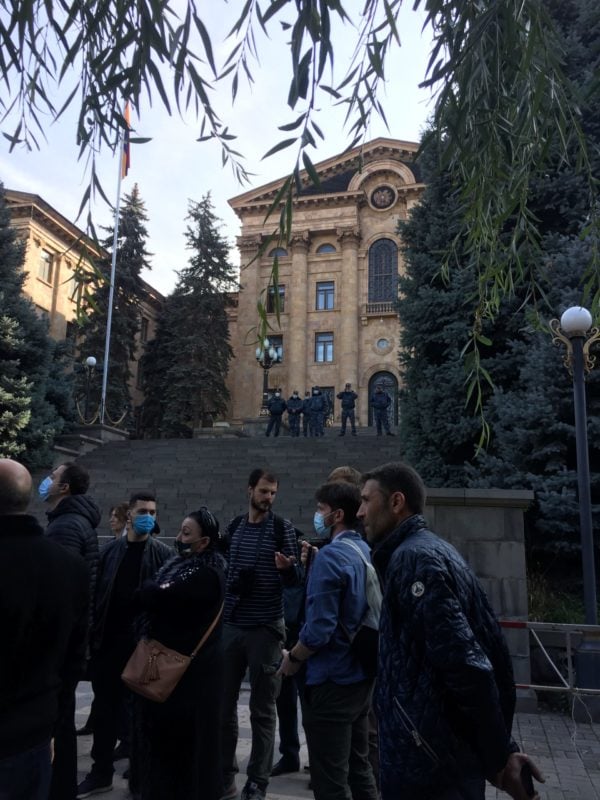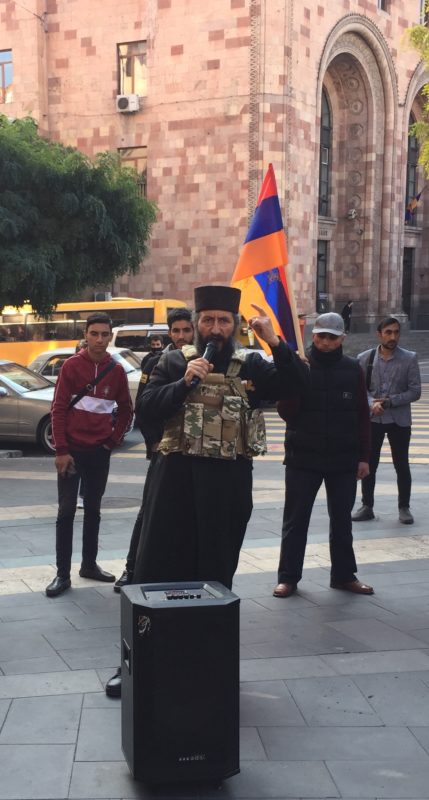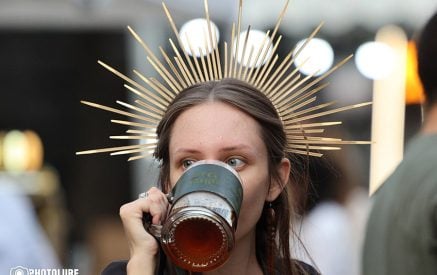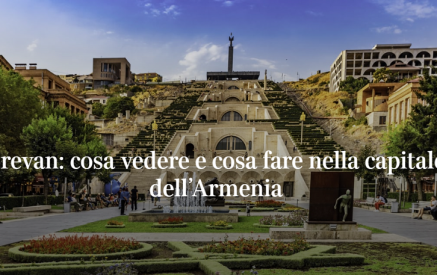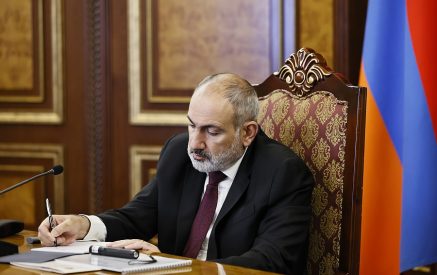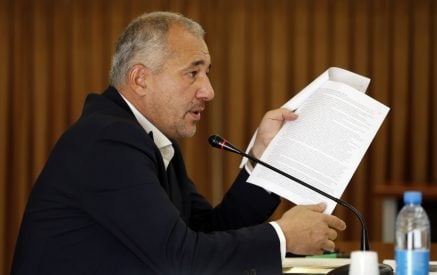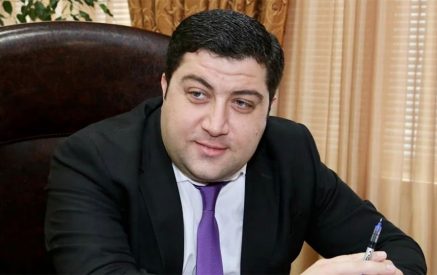The Armenian Mirror-Spectator. It was around 1:00 a.m. on November 10 that the people of Armenia were made aware of a shocking development: Prime Minister Nikol Pashinyan agreed to a Moscow-brokered truce effectively surrendering the bulk of the provinces that once made up the Republic of Artsakh.
Though the war’s prognosis had grown increasingly bleak on the Armenian side, this development nevertheless came as a great shock to many Armenians. In the days leading up to Armenia’s surrender, the atmosphere of confidence in Yerevan was hard to miss. Large billboards and digital signs proudly bore patriotic slogans (“We will win!”, “I continue working so we may win”), and scores of people on the homefront, ranging from Artsakh refugees to Yerevan locals, expressed confidence that the Armenians could still snatch victory from the jaws of defeat.
In the immediate aftermath of this morale-shattering announcement, scores of protestors stormed government buildings in the early hours of Tuesday morning, with some even managing to steal private property from Pashinyan’s own residence.
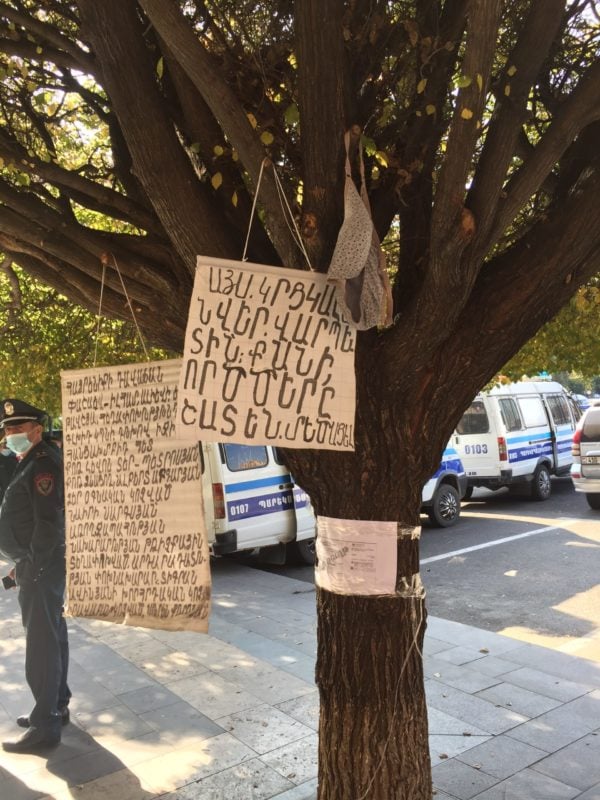
A bra hangs from a tree along with a sign with an emasculating message on it directed towards Nikol Pashinyan
Armenia’s House of Government, located on Republic Square, was heavily vandalized and its front entryways were significantly damaged by rioting. In the wake of an upswell in outrage and fury, Armenia’s opposition parties have taken this opportunity to launch an all-out offensive against Pashinyan’s government.
Read also
Parliament
Since morning scores of demonstrators have congregated on the grounds of the parliament. Despite a heavy police presence and the generally agitated nature of the crowds, the demonstrators have been largely non-violent, limiting themselves to animated arguments with fellow demonstrators, and the occasional shoving.
Opposition parties such as Prosperous Armenia took this opportunity to address the crowds from the steps of the parliament building. Armenia’s political spectrum encompasses around 17 opposition parties all of which called in a joint statement for rallies to be held in Yerevan’s center to protest the truce. The opposition parties have presented an outwardly united front, calling for Armenia’s agreement to the truce to be rescinded, and for the Pashinyan government’s resignation.
Republic Square
The iconic center of downtown Yerevan has been abuzz with demonstrations for the past two days. Various groups of people have congregated in front of the Armenian History Museum, setting up makeshift dioramas commemorating those lost in the war, and carrying signs and flags.
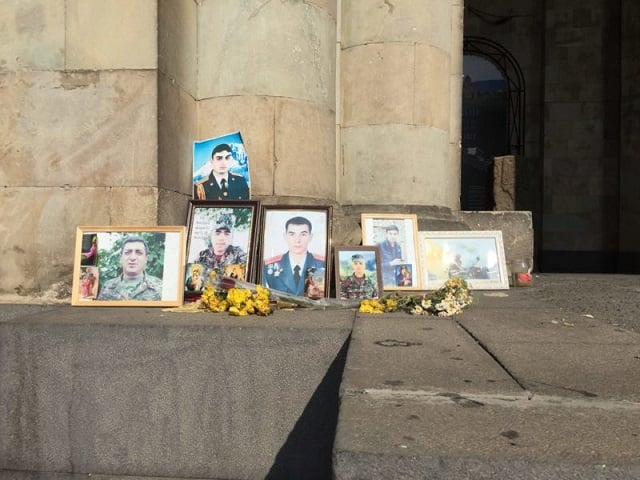
1. A makeshift diorama commemorating those lost in the war set up by protestors. Other demonstrators also held portraits of their lost loved ones.
Demonstrators were clearly disunited however, denouncing each other as instigators, arguing for or against Pashinyan’s decision, and for or against alliance with Russia. In one such incident, a middle-aged man declared loudly his belief in the benefits of siding with Russia, only for an elderly man to retort, “You fool! Russia has sold us out! Why do you speak such nonsense!?”, before storming off.
In the wake of its vandalization, the House of Government has now been surrounded by an army of police in riot gear, who have cordoned off the building whilst workmen began to repair the smashed glass at its front entrance. Scores of demonstrators jeered at the officers as they passed by, with some stopping to deliver long speeches denouncing Pashinyan’s government and the truce.
WEDNESDAY
Demonstrations continued into November the 11th, as picketers gathered in major centers in downtown Yerevan, including at the Opera and Republic Square. It appeared a significant increase over the attendance reported yesterday, with several hundred demonstrators grouped in these areas. Parliament’s gates have been closed, and no one has attempted to enter its grounds.
The areas where protestors have congregated have been the focus of a heavy police response, with police vehicles and officers surrounding the opera and Republic Square, causing significant traffic jams along Yerevan’s avenues.
At the opera, large numbers of protestors gathered along the steps of the opera building as police attempted to gradually push them away from the building. The situation, while chaotic, was mostly contained as officers were able to outnumber and overpower the demonstrators, who attempted to push back. Onlookers jeered at the police, calling them ‘Turks’ whilst others tried to compel the police to ‘change sides’ with bottles of water and chants.
Chants of “Nikol, traitor!” rung out at regular intervals as the crowd remained steadfastly defiant. Additionally, demonstrators were generally unwilling to give interviews to members of the press.
When asked why he had chosen to come, Mudik Baseryan a middle aged man, and one of the few demonstrators willing to speak openly, explained that he had come to understand what the reality of the situation is: “there is so much misinformation, and I just want to know what the truth is.” As with most of the attendees at the demonstration, Mudik was steadfastly opposed to the ceasefire agreement, particularly to its stipulation that Armenia must cede five of the seven provinces that encompass the Republic of Artsakh: “We must renegotiate this and the people of Armenia must be consulted this time. We cannot have this decision made by just one person in our name. We are all Varchapet so we must all be involved in this decision [meaning prime minister, referring to Nikol Pashinyan].”
This sentiment has been reflected in the rhetoric of oppositionists in recent days. Most notably, a priest from the Etchmiadzin diocese chose the front of the House of Government as his spot from which to deliver a fiery speech which had a similar message. Wearing an armored vest over his cassock and flanked by two flag bearers, the clergyman shouted angrily into his microphone, declaring that the loss of Shushi was “shameful” and branding Pashinyan “our traitorous Prime Minister.”
The priest characterized the truce as “surrendering the lands of Artsakh to Satan.” He also engaged in a homophobic rant, reminding the animated crowd: “Sodom and Gomora existed thousands of years ago, before god effaced them from the earth for their sins!”, adding “I cannot believe that we now have sodomites and homosexuals amongst the Armenian people! This is unconscionable!”.
Yerevan Remains Calm
Despite the widespread demonstrations in downtown Yerevan, the general normalcy of everyday life remains one of the most striking aspects of this difficult period in Armenian history.
Outside of the areas where police and protestors clash, the rhythm of city life continues. Many residents have continued to go to work and go about their daily lives, and across the street from troubled spots such as the Opera, locals sip coffee while lounging in outdoor cafes.
In much of the city, the only signs of this difficult period are the occasional blare of ambulance sirens, the distant roar of fighter jets, and the increased number of uniformed officers patrolling the streets.
For now, Yerevan – much like the rest of the country – remains in a precarious state of limbo as the incumbent administration attempts to weather the storm of public outrage.




















































